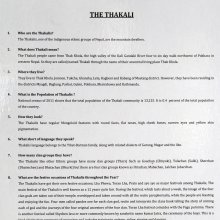Gandaki, Gaṇḍakī: 6 definitions
Introduction:
Gandaki means something in Hinduism, Sanskrit. If you want to know the exact meaning, history, etymology or English translation of this term then check out the descriptions on this page. Add your comment or reference to a book if you want to contribute to this summary article.
Images (photo gallery)
In Hinduism
Purana and Itihasa (epic history)
Source: Wisdom Library: Varāha-purāṇaGaṇḍakī (गण्डकी).—Name of a river originating from Himālaya, a holy mountain (kulaparvata) in Bhārata, according to the Varāhapurāṇa chapter 85. There are settlements (janapada) where Āryas and Mlecchas dwell who drink water from these rivers.
Bhārata is a region south of Hemādri, once ruled over by Bharata (son of Ṛṣabha), whose ancestral lineage can be traced back to Svāyambhuva Manu, who was created by Brahmā, who was in turn created by Nārāyaṇa, the unknowable all-pervasive primordial being.
Source: archive.org: Puranic EncyclopediaGaṇḍakī (गण्डकी).—(Gaṇḍaka) A river in Orthern India which falls into the Gaṅgā. Origin. There arose an argument between the Devas and the asuras about the Amṛtam (nectar) got from the churning of Kṣīrābdhi (the milk ocean) and Mahāviṣṇu appeared in the form of Mohinī and enticed the asuras away from the subject and gave the nectar to the Devas. Attracted by the great beauty of Mohinī, Śiva made love to her, and the sweet produced at the time of their embrace flowed as river Gaṇḍaki through the earth. (Skandha Purāṇa, Āsura Khaṇḍa). It became a holy river. While the worms on the banks of Gaṇḍakī were once collecting soil they fell into the river, and all at once they attained salvation, the reason being that the water in the river had been formed by the sweet of Viṣṇu and Śiva. And, from that day onwards people began worshipping Gaṇḍakī as a holy river. (Skandha Purāṇa, Āsura Khaṇḍa). Other information.
(i) He who drinks the water of the river is freed from sins. (Ādi Parva, Chapter 169, Verse 20).
(ii) The river is also known as Nārāyaṇī, Śālagrāmī, Hiraṇvatī and Hiraṇyavatī. (Bhīṣma Parva, Chapter 9, Verse 25).
(iii) Śrī Kṛṣṇa Arjuna and Bhīmasena once on their way from Indraprastha to Girivraja crossed this river. (Sabhā Parva, Chapter 20, Verse 27).
(iv) The water in Gaṇḍakī is a mixture of the waters of all holy rivers. Therefore, a bath in Gaṇḍakī is of equal value as an Aśvamedha yajña and he who bathes in it will attain Sūryaloka. (Vana Parva, Chapter 84, Verse 113).
(v) Gaṇḍakī is one of the rivers which were responsible for the origin of Agni (fire). (Vana Parva, Chapter 84, Verse 113). (See full article at Story of Gaṇḍakī from the Puranic encyclopaedia by Vettam Mani)
Source: Cologne Digital Sanskrit Dictionaries: The Purana IndexGaṇḍakī (गण्डकी).—(River) from the Himalayas visited by Balarāma;1 in the chariot of Tripurārī;2 a mahānadī.3
- 1) Bhāgavata-purāṇa X. 79. 11: Brahmāṇḍa-purāṇa II. 16. 26: Matsya-purāṇa 114. 22.
- 2) Matsya-purāṇa 133. 23.
- 3) Vāyu-purāṇa 45. 96: 108. 79.
Gaṇḍakī (गण्डकी) refers to the name of a Tīrtha (pilgrim’s destination) or River mentioned in the Mahābhārata (cf. II.26.4, II.82.97). Note: The Mahābhārata (mentioning Gaṇḍakī) is a Sanskrit epic poem consisting of 100,000 ślokas (metrical verses) and is over 2000 years old.

The Purana (पुराण, purāṇas) refers to Sanskrit literature preserving ancient India’s vast cultural history, including historical legends, religious ceremonies, various arts and sciences. The eighteen mahapuranas total over 400,000 shlokas (metrical couplets) and date to at least several centuries BCE.
Languages of India and abroad
Sanskrit dictionary
Source: DDSA: The practical Sanskrit-English dictionaryGaṇḍakī (गण्डकी).—
1) Name of a river flowing into the Ganges.
2) A female rhinoceros.
Source: Cologne Digital Sanskrit Dictionaries: Monier-Williams Sanskrit-English DictionaryGaṇḍakī (गण्डकी):—[from gaṇḍaka > gaṇḍ] f. Name of a river in the northern part of India, [Mahābhārata; Harivaṃśa] etc.
Sanskrit, also spelled संस्कृतम् (saṃskṛtam), is an ancient language of India commonly seen as the grandmother of the Indo-European language family (even English!). Closely allied with Prakrit and Pali, Sanskrit is more exhaustive in both grammar and terms and has the most extensive collection of literature in the world, greatly surpassing its sister-languages Greek and Latin.
See also (Relevant definitions)
Starts with: Gandakibhujangastotra, Gandakika, Gandakimahatmya, Gandakiputra, Gandakishila, Gandakishilamahatmya.
Ends with: Mrigandaki.
Full-text (+11): Gandaka, Gandasahvaya, Shaligrama, Citravana, Shalagrama, Gandakavati, Cakranadi, Shalagrama-shila, Vaishali, Shalagrami, Gandakishila, Gandakam, Saligrava, Gandakiputra, Shaligram, Narayana, Tirabhakti, Shila, Jalodbhava, Mahavana.
Relevant text
Search found 32 books and stories containing Gandaki, Gaṇḍakī; (plurals include: Gandakis, Gaṇḍakīs). You can also click to the full overview containing English textual excerpts. Below are direct links for the most relevant articles:
Rivers in Ancient India (study) (by Archana Sarma)
8. The river Gomatī in the Purāṇas < [Chapter 5 - Rivers in the Purāṇic Literature]
10. Various other rivers in the Purāṇas < [Chapter 5 - Rivers in the Purāṇic Literature]
11. Descriptions of the rivers in the Jambudvīpa < [Chapter 5 - Rivers in the Purāṇic Literature]
List of Mahabharata people and places (by Laxman Burdak)
Puranic encyclopaedia (by Vettam Mani)
Garga Samhita (English) (by Danavir Goswami)
Verse 8.13.58 < [Chapter 13 - A Thousand Names of Lord Balarāma]
Chaitanya Bhagavata (by Bhumipati Dāsa)
Verse 1.9.127 < [Chapter 9 - Nityānanda’s Childhood Pastimes and Travels to Holy Places]
Verse 2.3.108-114 < [Chapter 3 - The Lord Manifests His Varāha Form in the House of Murāri and Meets with Nityānanda]
Verse 1.14.41 < [Chapter 14 - The Lord’s Travel to East Bengal and the Disappearance of Lakṣmīpriyā]
The Skanda Purana (by G. V. Tagare)
Chapter 255 - Greatness of Lakṣmī-Nārāyaṇa < [Section 1 - Tīrtha-māhātmya]
Chapter 28 - Dharmadatta Attains Salvation < [Section 4 - Kārttikamāsa-māhātmya]
Chapter 33 - Dvārakā as an abode to all regions and places of pilgrimage < [Section 4 - Dvārakā-māhātmya]
Related products

